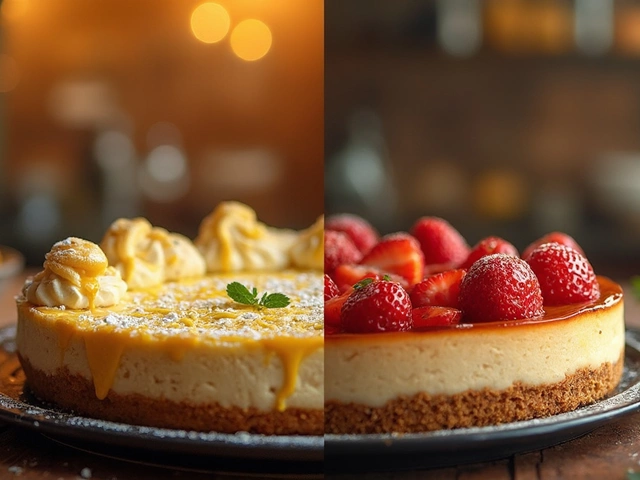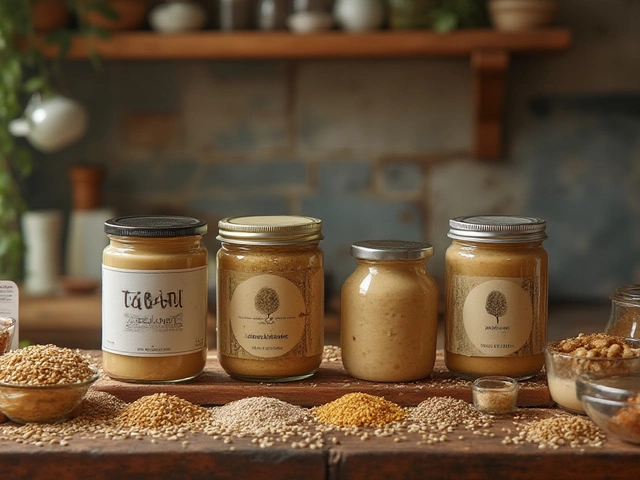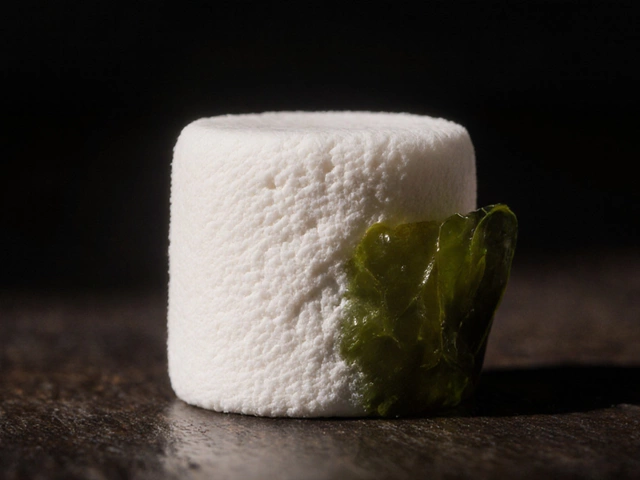
Have you ever wondered if the foods you eat show up on your skin? For those who are sensitive to gluten, this is more than just a curious thought. Gluten face is a term used to describe those telltale signs on your skin that suggest you've been indulging in some gluten-containing treats. Puffy eyes, redness, and blemishes are just a few ways your face might be telling you there's a sensitivity at play.
Diving into the connection between gluten and skin health can offer enlightening insights. Many people find that when they cut gluten out of their diet, their skin thanks them with a fresher, healthier glow. But this isn't just about vanity—it's about feeling your best inside and out. In this article, explore what gluten face looks like and find out how simple dietary swaps help bring out the best in your complexion. Plus, you'll discover easy gluten-free recipes to keep your meals delicious and your skin clearer.
- Understanding Gluten Sensitivity
- Recognizing the Signs of Gluten Face
- How Gluten Affects Skin Health
- The Role of Diet in Skin Appearance
- Simple Gluten-Free Recipes
- Practical Tips for Managing Gluten Sensitivity
Understanding Gluten Sensitivity
Gluten sensitivity is a condition that has gained a lot of attention in recent years, especially as more individuals identify with it. Many people experience discomfort when consuming gluten, a protein found in wheat, barley, and rye. Yet, they don't test positive for celiac disease, a severe autoimmune condition triggered by gluten. This sensitivity, sometimes referred to as non-celiac gluten sensitivity (NCGS), can manifest in various ways, impacting one's digestive system and beyond. Interestingly, the symptoms are not limited to just a gurgling, upset stomach. People often report an array of non-digestive symptoms, from fatigue and headache to joint pain and skin issues like the often-mentioned gluten face.
At the core of understanding gluten sensitivity lies a fascinating interplay between diet, our immune response, and the gut-brain-skin connection. While research is still uncovering the exact mechanisms, the current understanding is that gluten can lead to increased intestinal permeability, commonly known as 'leaky gut,' in sensitive individuals. When this happens, larger, undigested food particles can pass through the gut barrier and make their way into the bloodstream. The immune system sees these particles as foreign invaders, resulting in a range of symptoms that can even play out on one's complexion. This systemic reaction showcases how even the seemingly mild gluten sensitivity can have broad impacts, lending credibility to an individual's decision to steer clear of gluten-containing foods.
A World of Triggers
Gluten sensitivity is often confused with other food-related disorders, but it is crucial to recognize the unique nature of NCGS. While it's easy to attribute every symptom to gluten, many people in this category are sensitive to other components in wheat as well, such as fructans, which are fermentable carbohydrates. This means going gluten-free might not solve every issue if some of the symptoms stem from these other compounds. On the other hand, some people who initially claim relief from a gluten-free diet might feel better because they are avoiding processed foods, rather than gluten specifically. It's a complex knot, and simply blaming gluten isn't always the solution. To navigate these murky waters, many individuals turn to a nutritionist or a physician specializing in food sensitivities.
Such specialists often recommend a careful food diary or an elimination diet followed by a structured reintroduction phase. This approach often reveals specific triggers, helping people clearly identify whether gluten is a primary villain in their story. It's a trial-and-error journey but can be eye-opening, setting the stage for a healthier life with less discomfort, clearer skin, and a better sense of well-being.
"Emerging research suggests a significant portion of adults and children could be gluten-sensitive, but without celiac disease," says Dr. Alessio Fasano, Director of the Center for Celiac Research at Massachusetts General Hospital. "Identifying and understanding this early avoids the unnecessary complications later on."
Even if you suspect gluten might not be the entire culprit, adopting a gluten-free lifestyle brings its own joys and benefits. It opens up a world of exploring new foods and recipes that emphasize naturally gluten-free foods such as vegetables, fruits, lean meats, and whole grains like quinoa and rice. Living without gluten doesn't mean deprivation. In fact, it might lead to culinary adventures you never thought possible.
Recognizing the Signs of Gluten Face
When we think about how what we eat can affect our looks, skin isn't the first thing that usually comes to mind. But for those with gluten sensitivities, what they eat might be leaving clues right on their faces. Imagine waking up one day to find your reflection altered by a puffy face and under-eye bags that weren't there the night before. This all-too-common phenomenon for those sensitive to gluten can indeed be alarming.
Gluten face is a term that describes changes in facial appearance—particularly puffiness—caused by inflammation from gluten consumption. The face might appear swollen, especially around the eyes, and this isn't just from a rough night of sleep. The redness, which may resemble rosacea, and random blemishes are not uncommon either. These conditions, while not medically dangerous, often lead to discomfort and self-consciousness for individuals unaware of their gluten sensitivity.
Gluten and Your Complexion
The connection between gluten and skin issues lies in the body’s immune response. When someone sensitive to gluten consumes it, the body sees gluten as a foreign invader, sparking a cascade of reactions intended to protect us. Unfortunately, this defense mechanism can backfire, leading to skin inflammation. It’s similar to how allergies cause sneezing and itchy eyes, except in this case, the reaction happens on your skin.
This reaction can manifest differently due to individual physiological differences. Some may experience breakouts resembling acne, while others notice more pronounced facial redness. In some cases, cheeks take on a blotchy appearance that isn't improved by creams or traditional beauty routines. According to the 'Journal of Clinical Gastroenterology,' approximately 25% of people with a gluten sensitivity will experience some skin reaction. This statistic underscores the necessity of being aware of these subtle signs.
Self-Observation and Awareness
Recognizing these signs allows individuals to take proactive steps, potentially alleviating discomfort and improving their quality of life. Those suspecting they might have a sensitivity can begin monitoring their facial changes in relation to their diet. Keeping a food diary can reveal patterns, helping pinpoint whether gluten is indeed the culprit. Finding relief is often just a matter of removing gluten from one's diet, leading to a brighter complexion and increased confidence.
We’re learning more about gluten sensitivity as research progresses, but knowing the signs of gluten face on your own skin is invaluable. Remember, every person is unique. Our reactions are personal and what works for one might not for another. However, with careful attention and potentially professional guidance, a resolution could be just around the corner. As you begin your journey, know that you're not alone, and there's a community of people who've been down this road and have found answers that work for them.

How Gluten Affects Skin Health
In recent years, there has been a growing awareness around the impact of gluten on skin health, particularly for those with a sensitivity or intolerance. While gluten is a protein found in wheat, barley, and rye, its effects extend beyond the digestive system. For some, these effects manifest visibly on the skin, earning the term gluten face. The relationship between gluten and skin conditions is complex, involving immune responses that can lead to inflammation. This inflammation might show up on the skin as redness, acne-like bumps, or even more severe conditions like eczema or psoriasis. The skin, as the largest organ, acts as a mirror reflecting one’s internal health, hence changes in diet can often reveal themselves through changes in complexion.
There are several mechanisms by which gluten might trigger skin issues. For one, those with celiac disease, an autoimmune disorder triggered by gluten, have heightened odds of developing dermatitis herpetiformis, a chronic itchy skin rash. Even in the absence of celiac disease, non-celiac gluten sensitivity can still bring about skin problems. Inflammatory responses to gluten cause the release of cytokines, which are proteins that the body uses to signal inflammation; these can affect skin integrity and appearance, leading to puffiness and blemishes—a prime characteristic of a gluten face. A study from the Journal of the Academy of Nutrition and Dietetics highlighted that dietary adjustments, specifically reducing gluten, improved skin conditions in a significant number of participants.
Notably, the link between diet and skin isn't just anecdotal. Dr. Alessio Fasano, a well-regarded researcher in the field of gluten-related disorders, suggests that the gut-skin axis plays a pivotal role in understanding these issues. He suggests that gluten might affect the skin through a "leaky gut" phenomenon, where gluten leads to increased intestinal permeability, allowing inflammatory compounds to interact with various bodily systems, including the skin. This gives credence to observations from dermatologists and nutritionists alike, who notice improved outcomes in skin clarity and texture when gluten intake is minimized.
"The skin is often the window to our inner health," Dr. Fasano emphasizes, highlighting the intrinsic link between dietary intake and skin manifestations.
To truly understand the impact of gluten on skin health, it's crucial to consider the individual nature of gluten sensitivity. While some may see significant improvement with a gluten-free diet, others may need to explore additional dietary changes or skincare routines. It’s worth noting that while gluten is a big player in this arena, other factors such as stress, hydration, and skincare products also contribute to skin health. Therefore, adopting a holistic approach may help in achieving the desired complexion goals. By prioritizing skin-friendly foods, rich in antioxidants and anti-inflammatory properties, alongside excluding gluten, many have found not only aesthetic benefits but also a boost in overall well-being.
As more people become aware of the potential issues gluten might pose, the shift towards gluten-free recipes isn't just a trend—it’s a lifestyle choice for better skin and better health. Even amidst the rising popularity, it is always advised to consult with health professionals before making significant dietary changes. They can provide tailored advice and ensure nutritional balance is maintained. This aligns with the overarching aim of many to have a naturally clear, healthy, and glowing skin, without the nagging signs of gluten sensitivity holding them back.
The Role of Diet in Skin Appearance
Our skin often reflects what's happening inside our bodies, serving as an external indicator of our internal health. A poor diet doesn't just impact your waistline or energy levels; it can also take a toll on your skin's appearance. For those with gluten sensitivity, the foods they consume might offer more clues about their skin health than they realize. It's no secret that what we eat significantly influences how our skin behaves. Consuming excess gluten can lead to inflammation, which manifests on the skin through puffiness, redness, and even acne. The link between gluten intake and skin issues is not just anecdotal. A study published in the Journal of the Academy of Nutrition and Dietetics highlights that 60% of individuals with gluten intolerance also report issues with skin conditions.
When exploring the impact of diet on skin, certain nutrients take center stage. Antioxidants, for instance, are known for fighting off free radicals, thus helping to maintain skin's youthful appearance. Foods like berries, nuts, and kale are antioxidant-rich and can improve complexion. On the flip side, gluten-containing foods, often low in these beneficial nutrients, may exacerbate skin problems, particularly in those with gluten sensitivities. Gluten-free recipes can be packed with colorful, vitamin-rich ingredients, promoting healthier skin. Ditching processed gluten-laden snacks in favor of fresh produce can make a significant difference in your complexion.
According to dermatologist Dr. Sabrina Manion, "Eliminating gluten from the diet won't just lead to better digestive health but can also result in clearer, more vibrant skin." This assertion is echoed by numerous professionals who recommend dietary assessments as part of comprehensive skincare routines.
Understanding the importance of hydration and collagen-boosting foods also plays a crucial role in this dietary overhaul. Water is essential, keeping the skin hydrated and flushing toxins out of the body, while foods rich in vitamin C, such as oranges and bell peppers, aid in collagen production, enhancing skin elasticity and reducing wrinkles. These simple changes can provide noticeable improvements, reinforcing the idea that your diet is as vital to your beauty regimen as any lotion or serum.
For the gluten-sensitive, modifying one's diet doesn't just offer relief from digestive discomfort—it's a pathway to achieving a healthy and radiant complexion. Transitioning to a gluten-free mindset may seem daunting initially, but the tangible benefits to your skin and overall well-being can make this change worthwhile. By choosing the right foods, you’re not just nourishing your body; you’re opting for a lifestyle where the glow from within reflects outwardly.

Simple Gluten-Free Recipes
Creating gluten-free recipes is easier than many people might think. When it comes to a gluten-free diet, the key element is to use ingredients that, naturally, do not contain gluten—such as fresh fruits, vegetables, and lean proteins. You can enjoy versatile meals full of flavor and nutrition without the worry of gluten impacting your health. Here's where creativity comes into play, as you substitute traditional gluten-containing products with healthier alternatives. For instance, instead of using wheat flour, you can opt for almond or coconut flour, which not only adds a unique taste but also packs a nutritional punch.
Let's take a closer look at some of these alternatives with a delicious gluten-free banana bread recipe. All you need are ripe bananas, almond flour, a touch of baking soda, eggs, and a splash of vanilla extract to create this sweet delight. Mash the bananas until smooth, fold in the eggs and vanilla, then mix with the almond flour and baking soda until a batter is formed. Pour it into a greased loaf pan, bake it at 180°C, and in about 50 minutes, you'll have a moist banana bread that rivals any traditional version. This is just the beginning of your culinary adventure in the world of gluten-free baking.
Consider adding more herbs and spices to your dishes. Think about using cumin, coriander, or ginger which are naturally gluten-free and bring intense flavors to your meals. If you love pasta, zucchini noodles or 'zoodles' are a fantastic alternative. Spiralize the zucchini and sauté with garlic, tomatoes, and a sprinkle of basil for a refreshing dish. This keeps your meal light, fresh, and most importantly, free from gluten. Here's an interesting data point for you: Studies suggest that, worldwide, nearly 30% of people choose to reduce their gluten intake even without a formal diagnosis of celiac disease, indicating a rise in awareness and preference for gluten-free diets.
Quinoa is another champion in the gluten-free world. It’s a complete protein and cooks just like rice, but with a nuttier flavor and more nutritional value. You can prepare a lovely quinoa salad with diced cucumbers, cherry tomatoes, and fresh parsley. Dress it up with olive oil and lemon juice, and you have a side dish or standalone meal that's vibrant, satisfying, and completely free from gluten. As the gluten-free community continues to grow, so does the creative reservoir of recipes and options that cater to this dietary choice. "Adopting a gluten-free lifestyle often opens up a world of healthier, interesting alternatives you may have never considered," says nutrition expert Sarah Murray.
Last but not least, snacks shouldn't be overlooked in your quest for gluten-free options. Consider roasted chickpeas or nuts with a hint of sea salt as satisfying alternatives. These can be perfect for that afternoon energy slump. Now, with these recipes in hand, you have the foundation to explore endless possibilities while keeping your meals exciting and gluten-free. Whether you're living with gluten sensitivity or simply prefer to eat gluten-free, experimentation in your kitchen can lead to discovering new favorites, all while keeping your skin, and body, at its healthiest.
Practical Tips for Managing Gluten Sensitivity
Managing gluten sensitivity can often feel like a full-time job, but it doesn't have to be. The key lies in a combination of education, preparation, and a sprinkle of creativity. First, it's important to fully understand your body's reactions. Keep a journal of what you eat and any physical reactions you experience, especially those affecting your skin. This will help to identify triggers and avoid future disruptions. Knowing what to look for in ingredient lists can prevent accidental gluten consumption, which often hides under different names. Ingredients like malt vinegar, soy sauce, and some artificial flavors are just a few of the less obvious places where gluten can lurk.
Another vital step is creating a kitchen environment that's safe and inviting. Dedicate a section of your kitchen to gluten-free cooking and storage. This helps minimize cross-contamination risks. Invest in essential appliances, like a separate toaster for gluten-free bread, since crumbs can carry gluten, keeping your food prep areas pristine is crucial. It's also beneficial to research and connect with community resources, whether it's local stores specializing in gluten-free products or online forums where you can share experiences and recipes. Finding a supportive community can provide encouragement and new ideas, particularly when you're feeling limited by your diet.
"Adopting a gluten-free lifestyle can bring profound changes not only to your health but also to how you connect with your meals." — The British Coeliac SocietyDining out might seem daunting, but it can be done successfully with a bit of strategizing. Before visiting any restaurant, call ahead or check their menu online to see if they offer gluten-free options. Don’t shy away from asking how your meal is prepared or requesting that certain steps be taken to prevent cross-contact with gluten during cooking. Restaurants are becoming increasingly accommodating as more people prioritize dietary needs, so feel empowered to speak up about your requirements.
When it comes to planning meals at home, keep your cupboards stocked with versatile gluten-free staples like quinoa, rice, and gluten-free oats. Fresh fruits, vegetables, and lean proteins are naturally gluten-free and serve as the basis for a varied diet. This approach ensures you're never caught off guard by hungry moments. Exploring gluten-free recipes can reignite your love of cooking, experimenting with different spices and cuisines that are naturally free from gluten can open up a whole new world of flavors and textures. And remember, there are endless dessert possibilities too. Gluten-free baking might take some practice, but with perseverance, you'll master it.
Finally, it’s vital to stay informed about advances in gluten-free living. Science is continually evolving, and new products are constantly being developed. Books, blogs, and gluten-free advocates can offer fresh perspectives and updates that keep your meals exciting. Managing gluten sensitivity is a journey of discovery, one that can ultimately lead to a healthier, more mindful approach to how you nourish your body. By using these tips, you can effectively control your symptoms and enjoy a lifestyle that's both balanced and fulfilling.




